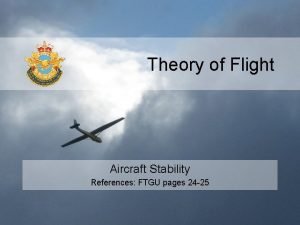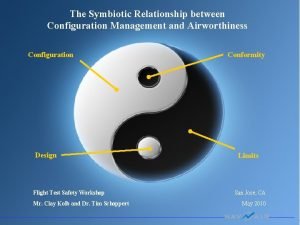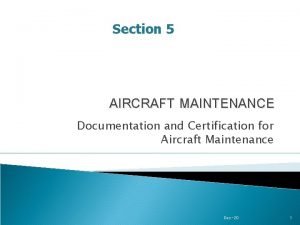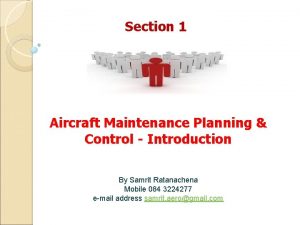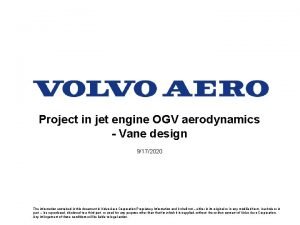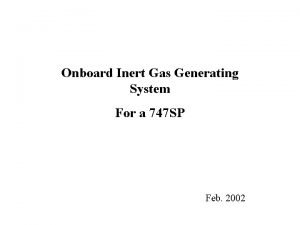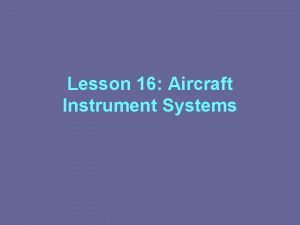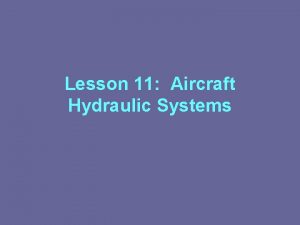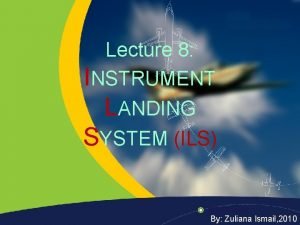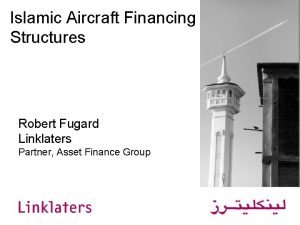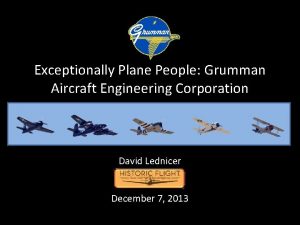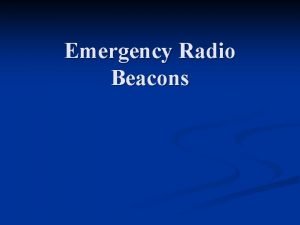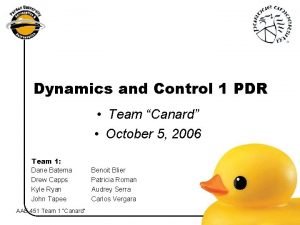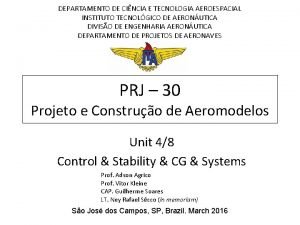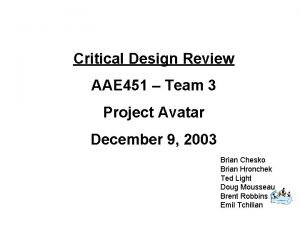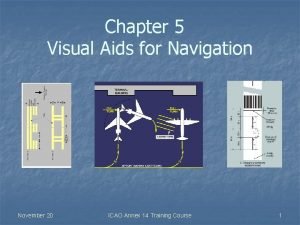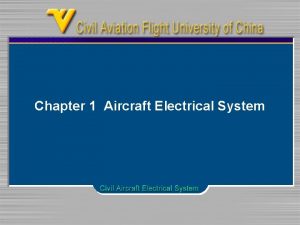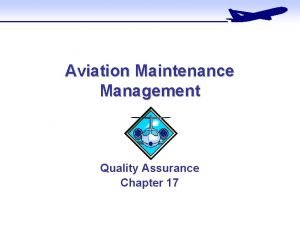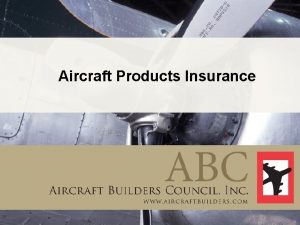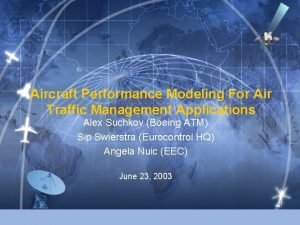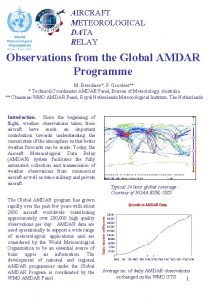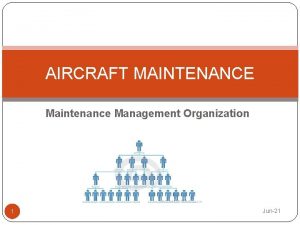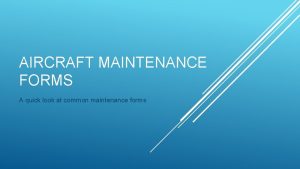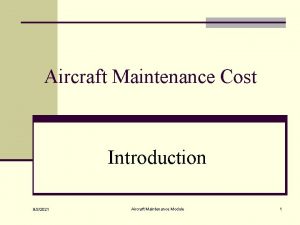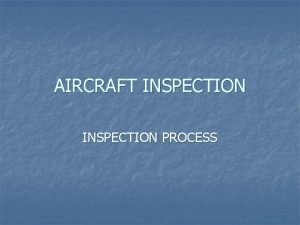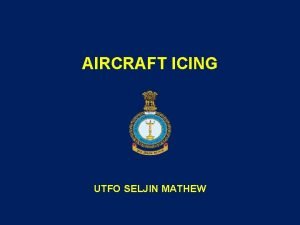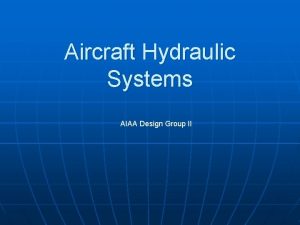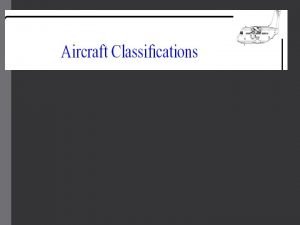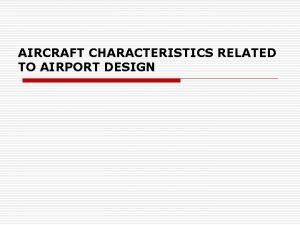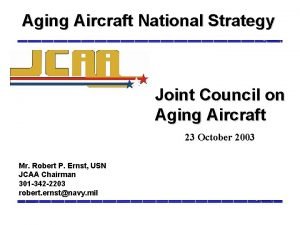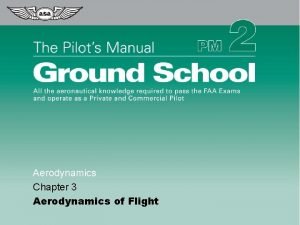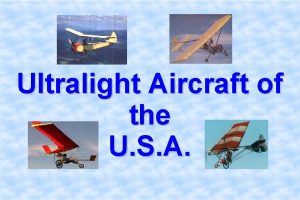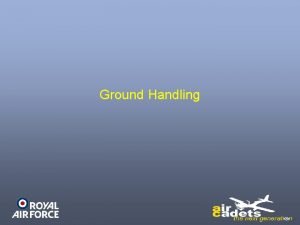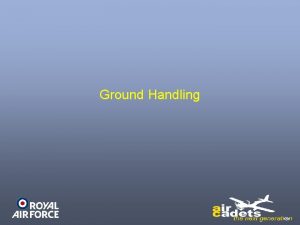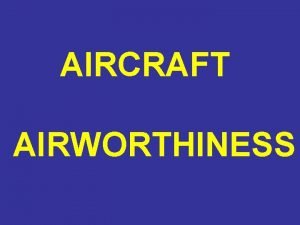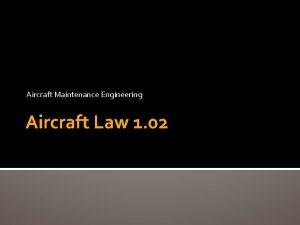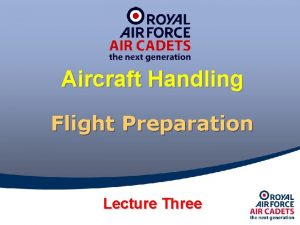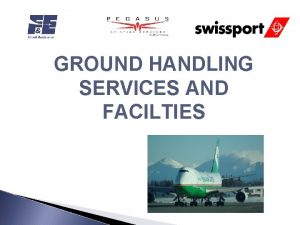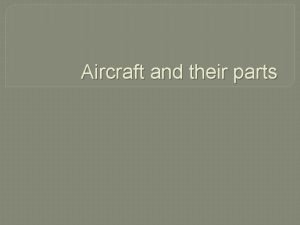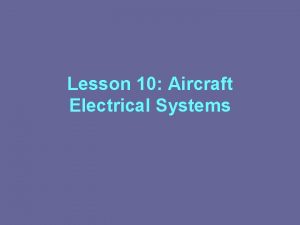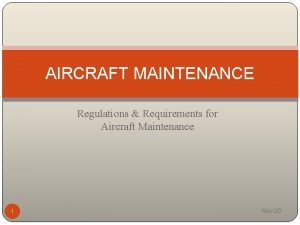Aircraft Handling Ground Handling Lecture Two Ground Handling



































- Slides: 35

Aircraft Handling Ground Handling Lecture Two

Ground Handling Aircraft arrivals and departures are usually attended by two tradesmen known as The Handling Team The handling team will marshal an arriving aircraft into a parking area which has been cleared of FOD is Foreign Object Damage objects which have the potential to damage aircraft either by being sucked into an engine, blown by jet efflux into another aircraft, or damaging aircraft tyres.

Ground Handling The Handling Team will insert chocks and connect necessary power and ground servicing equipment. Position fire extinguishers during engine shut-downs. Position aircraft steps and assist the aircrew with unstrapping. Finally the handling team fit safety devices (safety pins, covers, blanks and plugs) that may be needed.

Marshalling The aim of the marshaller is to assist the pilot in the safe manoeuvring of the aircraft on the ground. The marshaller communicates with the pilot by making visual signals with his arms and hands, but the pilot is not required to comply with marshalling instructions he considers to be unsafe.

Marshalling The extent of assistance will depend upon: The number of obstructions, The size of the aircraft, The field of view from the cockpit, The pilot’s familiarity with the airfield. At an unfamiliar airfield taxiing instructions can be passed to the pilot by radio; For a long taxi route, marshallers may be stationed along the route at intervals, or “follow me” vehicles may be used.

Marshalling Night Marshalling Taxiing at night requires more detailed marshalling directions, and navigation lights must always be on, and taxi lights used. When using taxi-lights, care must always be taken to ensure that the marshaller is not dazzled. Taxi Lights Nav Lights Marshallers carry wands for identification and must be visible at all times by the pilot. If the pilot looses sight of the marshaller they must stop and wait for them to catch up.

Marshalling Signals Affirmative (I will comply or I understand) Hand raised, thumb up. Negative (Not clear or I will not comply) Arm held out, hand below waist level, thumb turned down. This Way Arms above head in vertical position with palms facing inward.

Marshalling Signals Proceed to Next Marshaller One arm down, other arm moved across the body to indicate direction. Turn to Left or Right One arm down, other moved upward and backward. Speed of movement indicates rate of turn. Fire Make rapid horizontal figure of eight motion at waist level, pointing at source of fire.

Marshalling Signals Move Ahead Palms backward, repeatedly moved up and back. Slow Down Arms down with palms towards ground, then moved up and down several times. Stop Arms crossed above the head, palms facing forward.

Marshalling Signals Start Engine(s) Left hand overhead with appropriate number of fingers extended to indicate the number of the engine to be started, circular motion of right hand. Slow Down Engine(s) (on indicated side) Arms down, with left or right arm moved up and down, palm down.

Marshalling Signals Cut Engine(s) Either arm level with shoulder, with hand moving across throat palm down. Hot Brakes Arms extended with forearms perpendicular to the ground palms facing inward. Brakes ‘ON’ DAY Arms above head, open palms toward aircraft then first closed. ‘ON’ NIGHT Arms above head then cross wands. ‘OFF’ DAY Reverse of above. ‘OFF’ NIGHT Cross wands, then uncrossed.

Marshalling Signals Disconnect Ground Power Left fist partially clenched, right hand moved away withdrawing first two fingers from circle of left hand. NIGHT: Same as day signal with left wand held vertical and right wand held horizontal. Connect Ground Power Left fist partially clenched, right hand moved in direction of left hand two fingers inserted into circle of left hand. NIGHT: Same as day signal with left wand held vertical and right wand held horizontal.

Marshalling Signals Insert Chocks Arms down, fists closed, thumbs inwards, swing arms from extended position inwards. Remove Chocks Arms down, fists closed, thumbs outwards, swing arms outwards.

Towing and Parking Aircraft are never taxied in to or out of hangers – they are towed or manhandled instead. Handling parties must be qualified and consist of: An experienced supervisor. One person in the cockpit to operate the brakes. One at each wing tip to ensure obstacle clearance. Either a driver for the towing vehicle, or sufficient people to manhandle the aircraft.

Towing and Parking When parking an aircraft the handling party act in accordance with orders for that aircraft: a. Park the aircraft facing into wind so that no part of one aircraft overlaps any part of another. b. Double chock the wheels - fore and aft. c. Release the brakes. d. Check the electrical services, ignition switches and fuel cocks are turned off. e. Apply control locks. f. Fit pitot and static vents covers. g. Lock canopies and doors, fit canopy, wheel and engine covers and set drip trays.

Danger Zones Danger zones are those areas in which there is a high risk of injury to personnel when aircraft components or systems are operated on the ground. Danger zones include: Engine intakes - sucking Engine exhausts – blowing & hot Propellers – always considered as “live” Helicopter rotors – prone to “blade sail” where they rotate and bring the blades closer to ground height.

Danger Zones Wheel and Brake Fires Aircraft wheel brakes are made of two components: a pad of heat-resistant, hard-wearing fibre and a disc attached to the wheel. Friction between pad and disc slows the aircraft, it also heats up the disc – which can, in prolonged taxiing, abnormal loading or heavy landing, cause a fire. The Marshalling team are in charge of this until the Fire Service arrives.

Danger Zones Wheel and Brake Fires The safest course of first aid action against an aircraft wheel or brake fire is: To avoid the 3 -9 Line by standing forward or rearward of the wheels, depending on the prevailing wind, but never in line with the axle. To operate the fire extinguisher at the limit of its range, and to spray the extinguishant downwards, 0. 3 m away from the wheels.

Check Understanding What are the tradesmen who attend aircraft arrivals and departures known as? The Handling Team The FOD Team The Marshalling Team The Safety Team

Check Understanding What is the person who assists the pilot in the safe manoeuvring of the aircraft called? The Handler The Marshaller The Director The Supervisor

Check Understanding What is the meaning of this marshalling signal? Fire Proceed to Next Marshaller Turn Left Turn Right

Check Understanding How does the marshaller communicates with the pilot? By Radio By Semaphore By Hand Arm signals Through Air Traffic Control

Check Understanding What precautions should be taken when using taxi-lights? That the taxi-light bulbs are not burned out. That the marshaller should not be dazzled. That the aircraft batteries are not overloaded. That people in adjacent buildings are not dazzled.

Check Understanding What is the meaning of this marshalling signal? Stop Brakes This Way Move Ahead

Check Understanding Areas around propellers, engine intakes, exhausts, rotors etc. are considered as what? Activation Areas Blade Zones Rotation Areas Danger Zones

Check Understanding What is the effect called when a helicopter on the ground, has its engine running, and a gust of wind causes its blades to be closer to the ground than normal? Blade dropping Blade falling Blade sailing Blade slipping

Check Understanding What is the meaning of this marshalling signal? Brakes Remove Chocks Insert Chocks Stop

Check Understanding When fighting an aircraft wheel fire, where should you aim the extinguisher jet? 0. 3 m away from the wheels 0. 3 m above the wheels Directly onto the wheels 0. 3 m behind the wheels

Check Understanding What is the meaning of this marshalling signal? Fire Turn Left Turn Right This Way

Check Understanding At an unfamiliar airfield how can taxiing instruction be passed to the pilot? Via a TV link-up By ‘follow me’ vehicles Via Semaphore By Radio

Check Understanding What is the meaning of this marshalling signal? Connect Ground Power Disconnect Ground Power Insert Chocks Remove Chocks

Check Understanding Areas of high risk of injury to personnel when aircraft are operated on the ground are known as what? Danger Zones FOD Areas Hot Zones No-Go Areas

Check Understanding What light settings should a pilot use whilst being marshalled at night? Navigation and taxi lights on Navigation lights off, taxi lights on Navigation lights on, taxi lights off Anti-collision lights set to white

Check Understanding What is the meaning of this marshalling signal? Hot Brakes Stop Cut Engines Slow Down

Aircraft Handling End of Presentation
 01:640:244 lecture notes - lecture 15: plat, idah, farad
01:640:244 lecture notes - lecture 15: plat, idah, farad Sweepback lateral stability
Sweepback lateral stability Aircraft configuration management
Aircraft configuration management Maintenance
Maintenance Aircraft maintenance planning
Aircraft maintenance planning Ogv aviation
Ogv aviation Onboard inert gas generation system
Onboard inert gas generation system Logbook entry sample
Logbook entry sample Classification of aircraft instruments
Classification of aircraft instruments Double acting unbalanced actuator
Double acting unbalanced actuator Components of ils
Components of ils Robert fugard
Robert fugard Grumman aircraft engineering corporation
Grumman aircraft engineering corporation Beacon
Beacon Aircraft static margin
Aircraft static margin Aircraft static margin
Aircraft static margin Cpa aviation
Cpa aviation Aircraft static margin
Aircraft static margin Apron safety lines colour
Apron safety lines colour Aircraft electrical system components
Aircraft electrical system components Bank repossessed aircraft
Bank repossessed aircraft Aircraft quality assurance
Aircraft quality assurance Aircraft builders council
Aircraft builders council Bada aircraft performance summary tables
Bada aircraft performance summary tables Aircraft meteorological data relay
Aircraft meteorological data relay Airline maintenance management
Airline maintenance management Aircraft maintenance forms
Aircraft maintenance forms Aircraft maintenance cost breakdown
Aircraft maintenance cost breakdown Aircraft phase inspection
Aircraft phase inspection Types of aircraft icing
Types of aircraft icing Aircraft hydraulic systems
Aircraft hydraulic systems Aircraft group classification
Aircraft group classification Airport characteristics related to airport design
Airport characteristics related to airport design Aging aircraft solutions
Aging aircraft solutions Bank angle aircraft
Bank angle aircraft Light aircraft
Light aircraft

